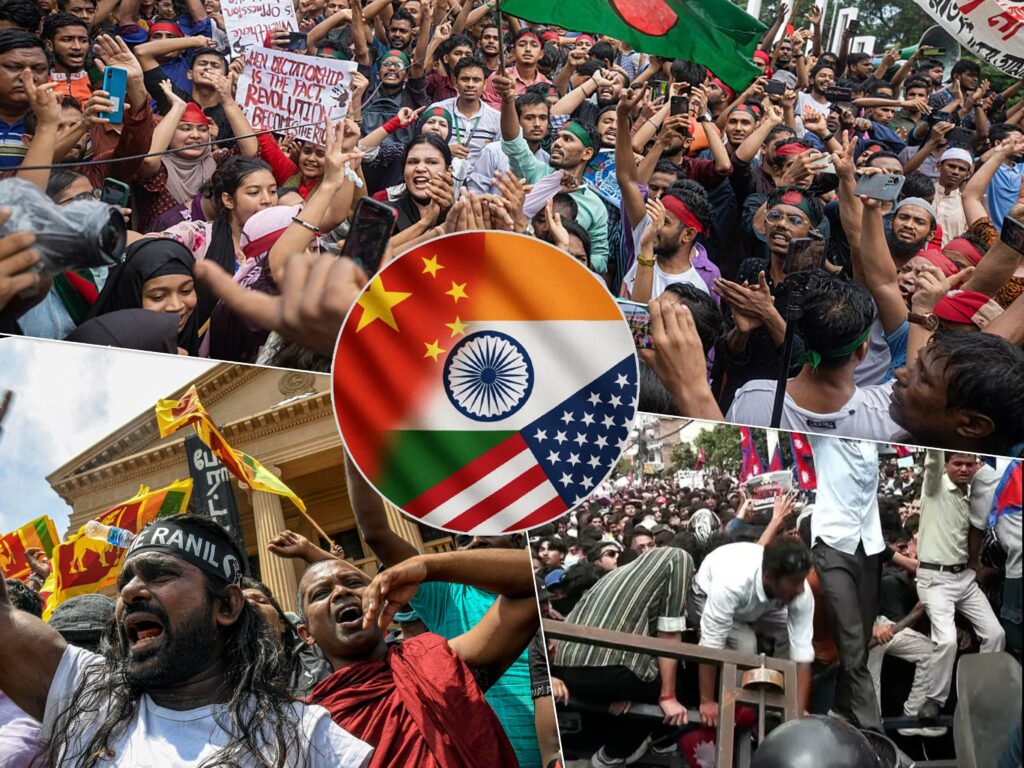
- This cycle of instability in India’s neighbourhood remains not only an internal matter but a regional one as well.
- Public protests demonstrated that an economy cannot grow without inclusive governance, and beyond a certain limit of economic growth, you cannot have democracy, or the population expects values of democracy to be meaningful.
- The crisis underscored the risks of debt-financed development ventures, especially those that are Chinese loan-associated.
- Finally, these crises demonstrate that national security is as much, if not more, tied to inclusiveness, governance, and institutional capacity as it is tied to military or economic power.”
Introduction
South Asia has long been a region of both opportunities and vulnerabilities. In the last twenty years, three nations in particular-Nepal, Bangladesh, and Sri Lanka-have witnessed political instability with fairly parallel trends. In each case, private citizens expressed their discontent over economic issues, misgovernance, and authoritarianism. In all three instances, governments with consolidated authority either fell or deserted in the wake of mass protests.
This cycle of instability remains not only an internal matter but a regional one as well. For neighbouring great powers India and China, these crises pose both risks and opportunities. As the premier geopolitical power of the world, instability in South Asia has bearings on the wider strategic considerations of the Indo-Pacific for the United States.
Case Study 1: Nepal – From Monarchy to Democratic Struggles
Rise of Public Unrest
The root cause of Nepal’s political instability can be traced back to a civil war (1996-2006) precipitated by the Maoist insurgency and revolt against the Monarchy. With the signing of a Comprehensive Peace Accord (2006) and the abolition of the Monarchy, the country had only a little time to distance itself from conflict and believe the country was embarking on a hopefully prosperous future. However, the stagnation of economic development, corruption and delayed (until promulgated in 2015) constitutional writing had created the conditions for civil discontent. The destruction from the earthquake in 2015 again revealed institutional weaknesses and heightened dissatisfaction. Prolonged street Revolts were becoming routine, in most cases resulting in violent clashes. The monarchy was dissolved in 2008, and after that, governments were fragile and unstable. Repeated failures in leadership exhibited public distrust. Leaders who threatened change merely created political paralysis as well and forced the people back into the streets.
Implications
- Nepal is now a weak democracy, open to populism and instability.
- The role of the public forcing governments to kneel has set the precedent of “street power,” undermining institutional governance.
Case Study 2: Bangladesh – Downfall of Sheikh Hasina’s Regime
Rise of Public Unrest
Under Sheikh Hasina, for many years, the country saw a slow drift towards authoritarianism. This was the concentration of power by her, the diminishment of dissenting voices, and accusations of electoral fraud, negating any claim to legitimacy through democratic means.
Worsening inequality, inflation, and unemployment among youth were some of the major issues in the 2020s, and the situation gave rise to frustrations around the country, especially in the student and worker groups. By the middle of 2024, the major cities of Dhaka and other surrounding big cities bore the brunt of nationwide protests.
Government Collapse
In 2024, the regime faced massive protests with calls for the resignation of Hasina. Security forces tried to suppress these, but swelling protest numbers overwhelmed the regime. She then fled the country, as did many other authoritarian rulers.
Implications
- Bangladesh has transitioned from being a so-called “development success story” to a cautionary tale of authoritarian overreach.
- Political uncertainty disrupted the supply chain in the garment sector and threatened consumption in the global retail markets.
- Public protests demonstrated that an economy cannot grow without inclusive governance, and beyond a certain limit of economic growth, you cannot have democracy, or the population expects values of democracy to be meaningful.
Case Study 3: Sri Lanka – The Rajapaksa Exit
Rise of Public Unrest
The various causes for the crisis in Sri Lanka are poor economic policy, corruption, and a reliance on debt. The ill-considered tax cuts made by the President in 2019, and then the restrictions on private business and loss of tourism income because of the COVID-19 pandemic measures, led to an untenable budget crisis. With food, fuel and medical shortages, ordinary citizens filled the streets in the wake of Aragalaya (struggle) protests by early 2022.
The protests brought together various social groups – mainly middle-class, students, and even professional classes – that were, at least at first, asking for accountability.
Government Collapse
Rioters breached the presidential palace in July 2022, and President Gotabaya Rajapaksa was routed. His family’s long tradition of decades in politics was suddenly over.
Implications
The crisis underscored the risks of debt-financed development ventures, especially those that are Chinese loan-associated. Sri Lanka’s economic meltdown was a canary in the coal mine warning for other vulnerable economies in the region.
Common Patterns Across Nepal, Bangladesh, and Sri Lanka
1. Economic Mismanagement – Either by corruption, unsustainable debt, or inflation, all three states did not achieve long-term economic stability.
2. Authoritarian Overreach – Rulers, downplaying the strength of popular discontent, banked on repression until it was unsustainable.
3. Street Power as Last Resort – People, disillusioned with institutions, resorted to mass protests to force change.
4 Government Flight – In every instance, top leaders were ultimately compelled to resign or escape, representing the complete collapse of state legitimacy.
Impact on India
Security Concerns
India’s border proximity with both Nepal and Bangladesh and maritime closeness with Sri Lanka expose it to imminent spillover threats:
- Refugee influx over porous borders.
- Emergence of extremist or insurgent forces taking advantage of instability.
- Increased stress on India’s border security forces.
Strategic Influence
In Nepal, India finds it hard to retain leverage in the face of increasing Chinese engagement in trade and infrastructure.
In Bangladesh, Cross-border connectivity projects and trade corridors that India depends on are threatened by instability.
In Sri Lanka, India had to walk a tightrope carefully, sending emergency relief while countering Chinese inroads in Colombo.
Domestic Political Dimension
India must not ignore these crises because they have implications for its own domestic politics, especially in border states like West Bengal, Assam and Tamil Nadu, which are (politically) sensitive areas for ethnicity and migration.
Impact on China
Strategic Setbacks and Opportunities
China, under its Belt and Road Initiative (BRI), heavily invested in South Asian infrastructure projects. However, turmoil in these nations makes Beijing’s strategy difficult:
- In Sri Lanka, the Hambantota Port has become an international symbol of “debt-trap diplomacy.” The Rajapaksa collapse emboldened China but did not erase its economic dominance.
- In Nepal, China tried to build influence but was checked by political turmoil and anti-China protests.
- In Bangladesh, Chinese companies continue to be present in energy and infrastructure, but the political uncertainty poses risks for investors.
Soft Power Crisis
The constant linking of Chinese loans with economic meltdown smears Beijing’s reputation. It compels China to rethink its strategy, providing debt restructuring while attempting to retain a presence.
Global Dimension – Influence on the USA
Indo-Pacific Strategy
Instability for the United States intersects with its wider Indo-Pacific strategy to contain China:
- Instability makes it difficult for the U.S. to establish stable partnerships in the region.
- The weakening of governance creates openings for China to exploit, even amid public backlash.
Economic Impact
- Disruptions in Bangladesh’s garment exports affect U.S. retail markets, raising costs for American consumers.
- Maritime instability in Sri Lanka threatens shipping lanes critical for global trade, which the U.S. Navy seeks to secure.
Strategic Opportunity
The US can intervene with economic assistance, democratic support initiatives, and security alliances to restore credibility in South Asia. That serves Washington’s interest in supporting a “free and open Indo-Pacific.”
Conclusion
Nepal, Bangladesh, and Sri Lanka have stories exhibiting a familiar pattern in South Asia: economic hardship leads to popular agitations, autocratic leaders misjudge the nation’s will, and eventually, governments are toppled or change course.
For India, it is a problem of strategy and a way to strengthen regional links. For China, it complicates the Belt and Road Initiative and highlights the consequences of debt diplomacy. For the USA, it is a vulnerability to stability but also an opportunity to reinforce its Indo-Pacific strategy.
Finally, these crises demonstrate that national security is as much, if not more, tied to inclusiveness, governance, and institutional capacity as it is tied to military or economic power. The crises in South Asia are not only regional, but are in fact a global geopolitical crisis for the great powers of the world.
Divyanka Tandon holds an M.Tech in Data Analytics from BITS Pilani. With a strong foundation in technology and data interpretation, her work focuses on geopolitical risk analysis and writing articles that make sense of global and national data, trends, and their underlying causes. Views expressed are the author’s own.
